Author: Elias Tazartes, co-founder and CEO of Kakarot zkEVM; Translation: Golden Finance xiaozou
Kakarot zkEVM is about to enter the test network release, we would like to reiterate our vision: why the rollup field still needs another A zkEVM?
This article will answer this question by exploring what makes Kakarot different, how it provides the simplest and most future-proof architecture, and why Kakarot is important to end users and developers. question.
Disruptive EVM builders expand the user experience design space and they will see a warm and friendly environment at Kakarot.
1, KakarotIntroduction
Kakarot is zkEVM built using Cairo, the language for Starknet and all StarknetOS chains ( A verifiable language supported by the CairoVM chain or Starknet application chain). Kakarot is an Ethereum-compatible zkRollup that aims to achieve full equivalence without compromise over time. In addition to compatibility, Kakarot is also working to drive more innovation in the L2 space and add new features to the EVM such as native account abstraction. The driving spirit of Kakarot is proof, expansion and innovation.
2, KakarotVision
In this article, we will introduce what makes Kakarot unique and why it is important to the ultimate Users and builders matter. After years of development of the Ethereum ecosystem, we have formed three firm beliefs. We hope to solve problems and realize our vision through Kakarot.
It doesn’t matter if TPS exceeds a certain threshold. Users want a level of responsiveness comparable to web2 applications and fast web3 dApps. In other words, users want sub-second transaction speeds. This usually means it will take several years to reach 10,000 TPS (we still need to solve the state growth problem together).
Transaction costs are a major barrier to adoption. As Vitalik said in a blog post: "I think the culprit behind this shift (less openness of web3) is rising transaction fees." Transaction costs should eventually drop below a penny to free people to experiment and innovate.
Another major barrier to mass adoption is user experience. At Kakarot, we believe the current state of web3 user experience needs to improve significantly. For example, we aim to provide an alternative for those who don’t want to manage mnemonic phrases, or those who are looking for the one-click experience (i.e., multi-call) that is available on most dApps.
Summarizing these three points, Kakarot can form its commitment to users and its position in the current Ethereum rollup competition:
While providing low-cost and fast transactions, Kakarot aims to lead the way with account-based abstractions (multiple calls, secure enclave signer, etc.) and rapid feature releases (e.g., before large User-centered innovation like most similar EIP).
3, KakarotDesign: the inevitable separation of cryptography and engineering
In a sense, Kakarot’s Architecture is a given because it is created from first principles. The core of Kakarot is built using the high-level language Cairo. This makes Kakarot the only zkEVM that truly separates cryptography and engineering, with cryptography and engineering corresponding to the "zk" and "EVM" in zkEVM respectively (except for zeth and SP1's Reth, which are currently in the research stage).
What does this separation mean for our team? That means faster development, less code (much less than you would need to write for a custom circuit), easier maintenance, and a showcase for all of Cairo's innovations in verification and open source software.

The idea of separation is not only Elegant, and the only way to support future expansion. It has proven to be very difficult for zkEVM to build custom circuits to support mainnet hard forks and innovate by integrating new EIPs in advance.
We believe that more players in this space will move to provably intermediary virtual machines. Today, two options for writing provable and adaptable software are:
Use LLVM languages and proving it, like Rust to LLVM, to Risc-V using RISC-ZERO vkVM proofs (like revm's Rust code becoming provable is zeth).
Using Cairo, a "provably designed" programming language built for CairoVM.
We are confident that Cairo will always have better performance (while other zkVMs may be more convenient) because it is built with a proof-of-concept philosophy, unlike other zkVMs. In the coming years, Cairo will prove to be the most practical and efficient tool for writing provable software.
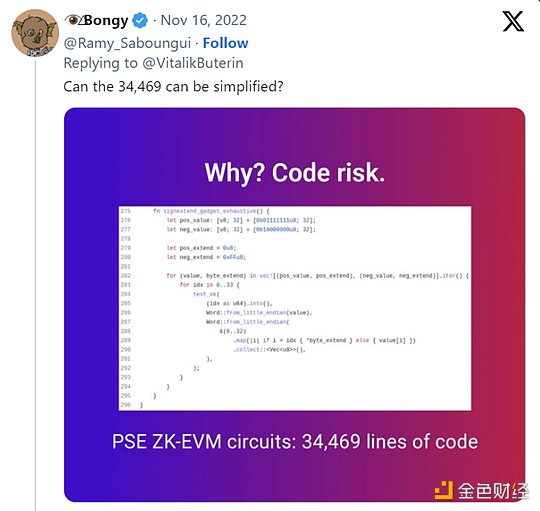
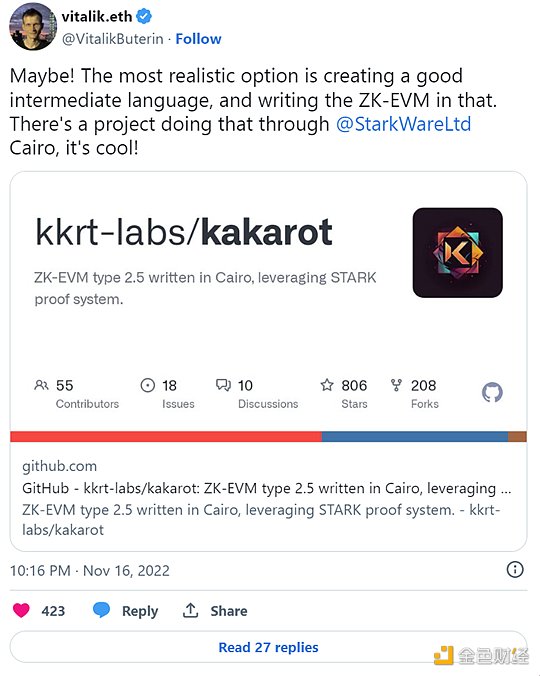
4 , Committed to being user-centered
It is certainly good to develop simple and easy-to-use software, but end users do not care about these. They don’t care whether Whatsapp’s backend runs on AWS or its own cloud, or which programming language Telegram is written in. End users expect clear added value.
The challenge we face in building Kakarot is to translate this huge engineering advantage (a high-level provable intermediary language) into added value for our community.
We want to demonstrate our ability to quickly adapt to changes in Ethereum. The first two clear advantages we offer the community are:
Kakarot zkEVM will be available immediately Integrated Dencun mainnet hard fork: all new opcodes and updates will be incorporated (tstore, etc.).
A collaborative product roadmap, user testing, and iterative construction.
Let’s take a moment to understand the second point. We are free and we can implement important features quickly (because our community chooses). During our testnet phase, we will release new features and ask our community to pick the most useful ones. We're excited to try out some of our ideas on our test network: native multi-calling, EOA with faceID (or hardware signer), mobile-first native account abstraction, EOF early integration, and more!
As we explore new features with our community of builders and end users, please remember that Cairo and its ecosystem are actively being developed behind the scenes! More than 100 Starkware employees are hard at work creating the next generation prover for Cairo. At the same time, more than 500 developers and infrastructure participants in the Cairo developer community are building new code bases and breakthroughs that Kakarot will be able to integrate in the future (such as parallel execution).
A good example that reflects our competitive advantage is the latest prover improvement research launched by Starkware in cooperation with Polygon Labs: Circle STARK. Cairo is getting stronger and stronger!
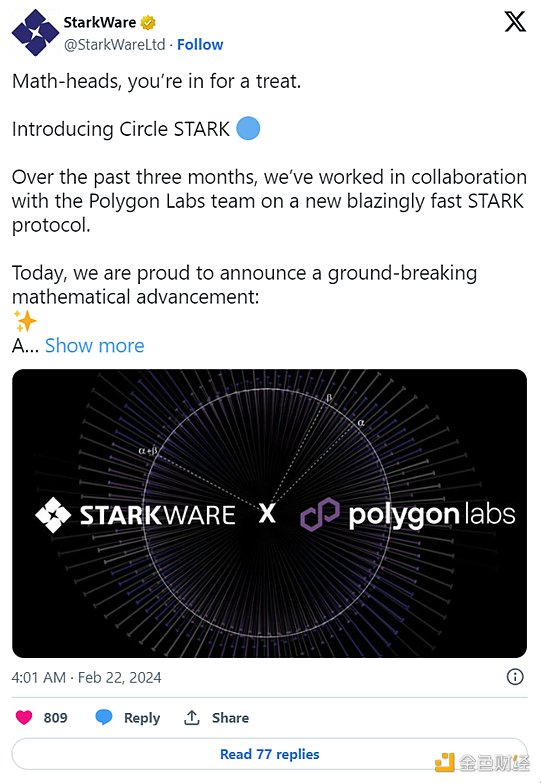
Kakarot can not only use The innovations of the vibrant Cairo ecosystem (proven speed improvements, support for open source code libraries such as secp256r1), and high-speed development with strong flexibility (accommodating hard forks and EIPs).
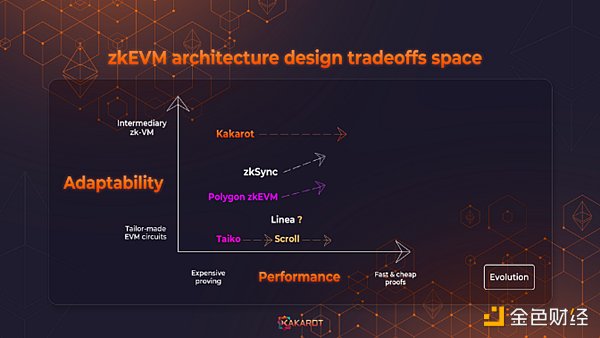
5 , KakarotLatest updates
In the spirit of pure consistency and the motto of "it just works", Kakarot aims to pass 100% Ethereum testing (official Ethereum Foundation EVM test). This milestone will confirm our full compatibility with Ethereum and will also free developers from EVM fragmentation worries.
In this way, Kakarot will provide a seamless development experience, and EVM builders can expect to work smoothly without any glitches or incompatibilities with the Ethereum mainnet. We want developers to focus on what matters to them: their protocol or dApp.
Now, Kakarot has passed more than 90% of the tests (that is, more than 18,000 tests). We've built confidence in our EVM implementation, now it's time to face the real world.
The latest news about Kakarot is that we are entering the testnet stage! To achieve this, we are partnering with Karnot and Starkware, who will help us run our stack. Over the next two quarters of 2024, we will be validating our technology with you (hopefully) and with our community. You can pay close attention to our updates on Twitter to learn about the opening date of the public testnet! Currently, the testnet is not open to the public.
The following is a simplified diagram of how the Kakarot test network works:
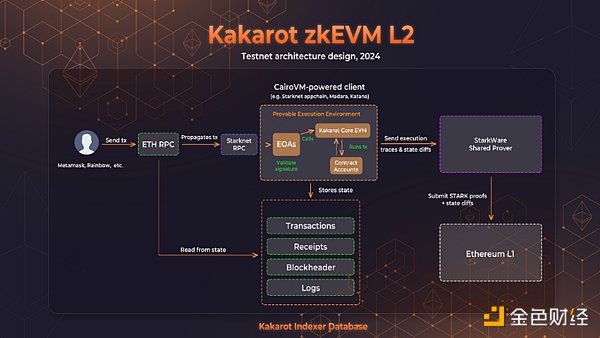
6, Conclusion
Kakarot latest news: The test network will be launched in the second and third quarters of 2024.
Kakarot’s unique advantage lies in its design: standing on the shoulders of cryptography giants and focusing on engineering. Take advantage of this to become a more adaptable team and release products faster (~6 people and contributors built 2 unique zkEVM implementations in less than a year).
Kakarot’s goal is to be 100% compatible with the Ethereum mainnet. We are fully tested by the Ethereum Foundation to provide assurance to our community of builders. As of today, we have passed over 90% of Ethereum tests. Our goal is to provide developers with no mental burden when it comes to compatibility and functionality.
Kakarot’s mission is to bring more innovations to the L2 space (multiple calls, secure enclave signatures, paymaster, parallel execution, etc.) while supporting long-term development (type 1 zkEVM, proof-of-mainnet, pure equivalence wait).
By leveraging Cairo, Kakarot is both stable and rapidly evolving. Allow us a little arrogance: Kakarot is coming, we are meant to be.
 JinseFinance
JinseFinance












